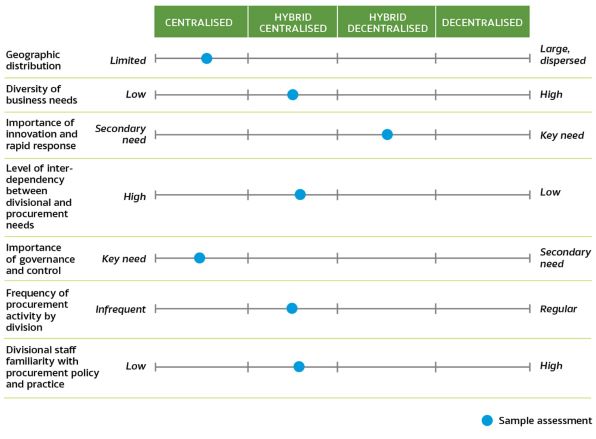What is the right organisational structure for your procurement team?

How do you set up the right organisational structure for your procurement team?
An important decision when answering that question is to set the degree of centralisation: which activities will be done by people outside of the immediate procurement team, versus which activities are done by that team themselves?
A centralised procurement team is one where a team of procurement professionals is established to undertake sourcing and contract management activities on behalf of the rest of the business. This means that all staff undertaking procurement directly or indirectly report to the Chief Procurement Officer. 19% of the participants in our most recent study have organised their procurement function around this model. It means they have maximum control over the procurement approach and outcomes, which often reflects the high risk nature of procurement within the organisation, or a low level of procurement maturity within the wider business.
On the other end of the spectrum is an organisation where procurement is decentralised to the business units or projects, who follow a governance structure and procurement policies that may be established by a small team of procurement professionals but the actual procurement activity is occurring within the wider business. Only one in nine teams follow this organisational structure, typically very small organisations.
The most common setup however is a hybrid model, where a centralised team may retain some activities, often around the sourcing of high and medium value or risky goods and services (41%). Often these hybrid-centralised teams also offer the services of a business partner, who is ultimately a procurement resource but is closely aligned with a specific business unit, providing procurement advice that is tailored to the needs of that specific business unit.
Lastly, an organisation-wide procurement policy team may provide guidance and help desk-type advice to procurers within a hybrid-decentralised model rather than undertaking procurement themselves. In this model, used by 29% of organisations, it is not uncommon that the business units have smaller procurement teams themselves which employ procurement professionals to undertake the procurements of that business unit, while following the policies and guidelines issued by the organisation-wide procurement team.

When choosing the right degree of centralisation, organisations often use a decision model like the one depicted at Figure 1. They determine for each criterion which organisational model best aligns with their needs and then consider the overall responses and which model aligns best to that.

Figure 1: Sample assessment against criteria to determine the right degree of centralisation for a procurement team
To read more about the degree of centralisation chosen by organisations depending on the volume of procurements they are undertaking and what best practice generally looks like in procurement in 2022, download our ebook Hitting the Reset Button







 We are all about sharing our expertise to help you and your organisation be the best it can be.
We are all about sharing our expertise to help you and your organisation be the best it can be.